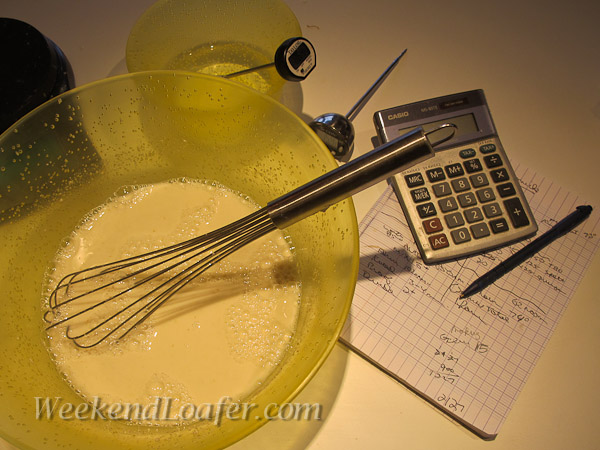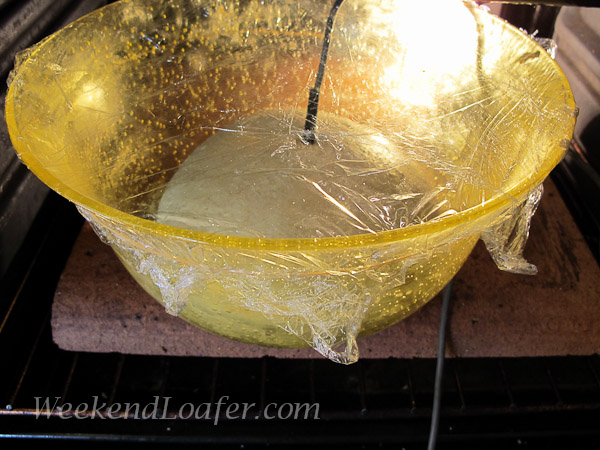
Yes … I am an obsessed baker … a truthful confession: if you are reading this you know what I mean. If I don’t get my hands in dough at least once a week, I swear I go into withdrawal! Sure you can get a quick fix at The Fresh Loaf, WildYeast, Stir the Pots, Fraine or countless other great sites, but it is just not the same! When I delved into uncharted territory with the experimental miche last week, it really bugged me that something just wasn’t right — after all, a bread should be able to stand up to a swift, gentle slashing! Don’t get me wrong…the miche looked, tasted and for most gourmands, would have been perfect, but I needed to get it right in order to move on to the next creation.
The solution to the “pillowy, bowl of loose Jell-O full of air bubbles” turns out to be a very simple one to fix … timing! I kept the formula the same (the first try I did not double it) and just slowed everything down a bit. Logically there are two ways to achieve this… by lowering the temperature or by decreasing the fermenting time. I chose the latter for this preparation and decreased the autolyse to a scant half hour, cutting the final proofing to one hour and letting the proofed Miche sit at room temperature at a cool 64° for a half hour while the oven was preheating. This seems to have made all the difference. The proofed miche had much more strength, and this didn’t change the final product a bit. The tan crumb was riddled with small even bubbles, the crust was crisp and brittle….and the taste was even better than I expected. It had a very moist, creamy mouth feel with a bit of a tang. Great with an aged goat cheese or with a smear of butter and confiture de figue!

An Experiment –Take two – Miche with high extraction wheat, spelt, quinoa and a smidgen of rye
Very Lo o s e l y Adapted from Daniel Leader’s Local Breads Pain Poilane
Desired dough temperature 76°
Makes 1 large miche
Levain Starter:
- 50 g stiff Levain starter
- 50 g Bio (organic) Whole Wheat Type 150 (90-98% extraction) added for the extra bran
- 50 g Bio Whole Wheat Type 80 (82-85% extraction)
- 75 g water
Ingredients:
- 333 g Bio Type 80 (82-85% extraction)
- 83 g Bio Spelt flour
- 83 g Bio Quinoa flour
- 8.5 g Type 130 Rye
- 375 g water
- 225 g stiff whole wheat Levain (all of the above)
- 10 g French gray sea salt
Bread method:
To show a comparison of the two bakes, the changed methods of the first bake are lined-out (first bake) and the second bake is shown in red (it looks messy but I hope it makes the point)
- Take your levain out of the refrigerator and mash the levain with a whisk in a bowl with the water. Add the flour and stir with a spatula until it comes together. Turned out onto the work surface and knead to incorporate the flours. Place the Levain in a covered container and let it sit at room temperature (76°) for 8-12 hours or until it has doubled in volume and the surface is domed. Mine tripled doubled in 8 hours at 76° 70°… slowed down the rise a bit.
- Pour the water into a large mixing bowl or the bowl stand mixer and mash the levain with a whisk until it is liquefied. Combine the flours until all the ingredients are incorporated. Cover and let the dough rest for 1 hour ½ hour, while the flour hydrates and the gluten begins to develop. (I could not fit my Kitchen Aid Pro in my suitcase, so I mix by hand… I autolyse/rest for one hour ½ hour, which I think really helps the gluten development)
- Kneading By hand: Turn the dough out onto your work surface. With floured or oiled hands knead a few strokes to bring the rough mass into a ball, flatten out the dough, evenly disperse the salt and continue kneading for 12 to 15 minutes. I found that this is a slack dough (it could have been that it had rained for 6 days straight and the humidity in the cottage was hair curling) and you will need to use a combination of the : Turn the dough out onto your work surface. With floured or oiled hands knead a few strokes to bring the rough mass into a ball, flatten out the dough, evenly disperse the salt and continue kneading for 12 to 15 minutes. I found that this is a slack dough (it could have been that it had rained for 6 days straight and the humidity in the cottage was hair curling) and you will need to use a combination of the this method if the dough is really wet to start with — (it seemed wetter this time) For the first couple of minutes it will be a sticky mess on your work surface, but do not yield to the temptation of adding more flour. Stop occasionally and use your bench scraper to gather any stray dough from your work surface. Continue until you have a good gluten development. I kneaded by hand for 15 minutes, let it rest and then continued for 10-15 minutes more. A good work out! You should be able to gently stretch a piece of the dough into a thin membrane that you can almost see through without it tearing. By machine: Add the salt and mix at medium speed until the dough cleans up the bowl and you observe a good gluten development.
Pictures of the process:
- Transfer the dough to a lightly oiled container. Cover and let it ferment at room temperature for one hour (76°). (I keep the dough at a consistent temperature 76° throughout.) If you would like to get a good overall picture of the bread making process for the home baker, I highly recommend you check out Mark’s videos at the Back Home Bakery.
- Turn the dough out onto your lightly floured work surface, fold the dough twice once (I needed to give it extra folds) and return it to oiled bowl with folds on the bottom and cover. Let the dough ferment for 2 to 3 hours 2 hours more. You can incorporate another fold after 50 minutes if you’re dough does not seem to have strength. (You might what to consider the extra folds depending on the type of flour used.)
- You can make one big miche with all the dough. I divided it into two pieces, one approx. 900 g and 1200 g and made one large boule and lightly pre-shaped it. Lightly flour the dough, cover and let rest for 10-15 minutes to relax the dough. (This dough was VERY relaxed…)
- Gently shape each piece of dough into a boule and place seam side up on a floured linen/towel in a bowl or into floured bannetons. Cover with a plastic bag or an oiled piece of plastic wrap and proof at room temperature for 2-3 hours — for the second preparation I removed the miche from the proofing chamber/oven with temperature controller, and left it at room temperature (64°for 45 min.) while the oven was preheating. When you press your floured finger gently on the dough, the indentation will spring back slowly. (Be careful…mine was over- proofed!!!)
- About one hour before baking, preheat the oven to 500° (with a baking stone in the middle of the oven and a tray in the bottom of the oven for steam). I like to add one cup of water to the bottom tray a few minutes before putting the loaves in the oven to produce a moist environment for baking the proofed loaves.
- Gently turn the proofed miche onto parchment paper or your floured peel. Score the miche. Slide the loaves onto the baking stone, turn down the oven to 470° according to Leader and continue to bake for 35 to 50 minutes. (I turned the oven down to 450° and then after 20 minutes, rotated the miche to get an even distribution of the heat.) If you are baking one big loaf, bake until the crust is walnut brown. For a good crust you want a bold bake, when you tap the bottom of the loaf you should hear a hollow thud (that is a technical term).
- Let cool on a wire rack before digging in. This bread gets better with age and will stay fresh up to a week or more.
If I can’t tell you…who can I tell? The sheep on the mountain don’t read English.
One of my posts, Pain de Campagne, is being featured in the Magnificent Sourdough section in Teresa’s blog “Discovering Sourdough.” North West Sourdough is the place to read about Teresa’s and other bakers’ experiences with sour dough, to find recipes for baking real sourdough at home … and much more! Check it out…..
This bread is being sent to YeastSpotting … the guest host this week is… Hefe-und-Mehr





































